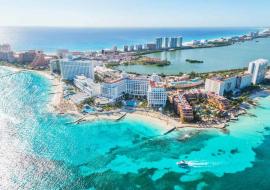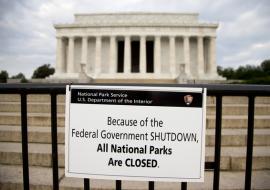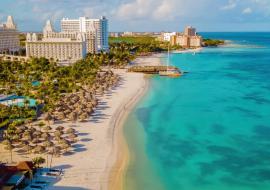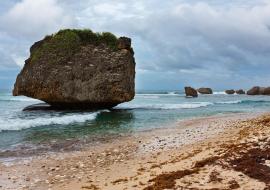Nearly 3.5 Million Canadians to Visit the Caribbean by Year’s End
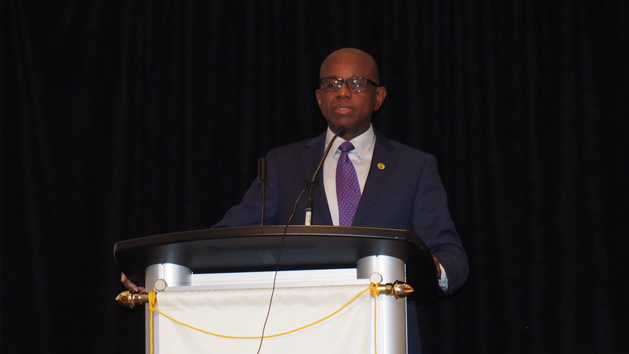
Not even Category 5 hurricanes can keep Canadians away from the Caribbean, as recent figures from the Caribbean Tourism Organization (CTO) have proven.
At a press conference in Toronto yesterday to highlight Caribbean Week in Canada, Hugh Riley, CTO’s Secretary General, praised Canada for being a “strong performer” in the first half of 2017, with arrivals up 6.4 percent when compared to the same period in 2016.
This was a significant rebound from what Riley referred to as an “uncharacteristically feeble performance” in 2015, when tourist arrivals from Canada fell by 3.4 percent.
Thankfully, he said, this downturn has made a quick turnaround, with this year’s strong performance contributing to an overall 5.2 percent growth in international tourist arrivals to the Caribbean in the first half of 2017.
“This was ahead of the growth rate of 2.5 percent-3.5 percent, which had been our CTO forecast, and it’s been a reflection of economic stability in the market, expansion and inauguration of flights by major carriers, and new marketing and product development initiatives,” he said.
The Canadian market is expected to continue to register growth this year despite Hurricanes Irma and Maria, which impacted approximately 25 percent of CTO’s member countries. By the end of 2017, the organization anticipates that the number of Canadians visiting the Caribbean will surpass the 3.4 million mark.
However, considering the strength of Irma and Maria, it’s understandable that travel to the region has been severely affected. As a result of blanket media coverage and travelers not realizing just how big and vast the Caribbean spans (Dominica to Grenada is the same distance as Toronto to Detroit, while Turks & Caicos to Curacao is more than twice the distance as Toronto to Montreal), there has been a slowdown in travel since the storms.
Consequently, the CTO – which projected robust growth prior to the hurricanes – has lowered its forecast for 2017 to between 1 percent-2 percent, with a similar growth rate projected for next year. The revised forecast is based on a number of factors, said Riley, including figures provided by CTO’s partner OAG, which reported that in the month of October, the number of flights to the region fell by 6.7 percent, while seat capacity contracted by 4.1 percent.
But Riley remains optimistic, saying that overall the year’s capacity to the region grew by 5 percent for the first nine months of 2017 when compared to the same period last year. In addition, the Conference Board of Canada, which expects the overall impact of the hurricanes to likely be “minimal, predicts that Caribbean airlift from Canada will be stable, with capacity up by double digits to about a dozen Caribbean countries through to July 2018.
The main takeaway message, stressed Riley, is that the Caribbean is open for business, and that some 75 percent of the region was “completely unscathed” by the hurricanes.
“Already virtually all the affected countries are reporting that they’re open again for business, although not at full capacity, with every one of them planning some sort of event either later this year or early next year,” he said. “We’re in the midst of gathering funds for an aggressive campaign across all media to get the message out that the best way to help the Caribbean is to visit the Caribbean.”
The first country to put money on the line to get the campaign up and running was Saint Lucia, which did not suffer any damage from the hurricanes. According to Dominic Fedee Minister of Tourism for Saint Lucia, who also spoke at the press conference, the island did not hesitate to come to the aid of affected sister islands, acting as a base for international humanitarian assistance in the aftermath of the storms.
“I’m so proud of the people of the Caribbean and the way they’ve been recovering. We’ve recognized one thing: the need for us to stay and work together, and to keep forging ahead in unity and strength,” he said. “That has been the spirit in which we’ve responded to this storm. We recognize that the Caribbean is strongest when all of our individual parts are operating at an optimal.”
Fedee went on to report that the Canadian market has paced ahead of the regional average, due in large part to the investment of Blue Diamond, the result of a partnership between European tour operator TUI and Sunwing.
“We are up 10 percent from Canada, which is performing very steadily for us. It’s our third largest market, and we continue to see tremendous dividends from the Canadian market,” he said.
With the Caribbean as a whole ending the year on a relative high note, Riley is already looking ahead to 2018, which he announced has been designated “The Year of Rejuvenation” in the region. Following the success of the Year of Romance in 2016, and this year’s Year of Adventure, next year’s theme will focus on the Caribbean’s wellness offerings, which range from beachfront workouts and yoga retreats to wellness resorts and spa treatments.
“The notion of being rejuvenated in our part of the world is one more reason to let us pamper you in 2018,” said Riley. “Together, let us invite everyone to help themselves to some Caribbean rejuvenation.”
Riley called on travel agents to help spread the word that the Caribbean is up and running, and that it has much more to offer than just beaches and all-inclusives. He credits agents for being strong supporters of the region’s recovery efforts, not only through bookings but also actively participating in the conversation.
Source: Travelweek Group








